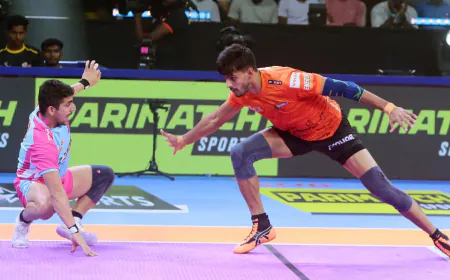Mohammad Rizwan's Strategy Under Fire Following Pakistan's Defeat Against India-Urooj Mumtaz's Take
Mohammad Rizwan's plan is under intense scrutiny following Pakistan's loss to India in the ICC Champions Trophy 2025. Pakistan's ex-cricketer Urooj Mumtaz gives her insight on the strategic mistakes that lost Pakistan the game.

The Pakistani cricket team were humiliated in a six-wicket loss against India in the much-awaited 2025 Champions Trophy match in Dubai. During the post-match critique, the erstwhile captain of the Pakistan women's team, Urooj Mumtaz, had no qualms about criticizing the team's captain, Mohammad Rizwan. She cited the fact that Rizwan's sluggish batting in the middle overs was one of the key factors for Pakistan not being able to set up a more competitive score.
In spite of scoring 46 runs, Rizwan gulped down 77 balls and faced 29 dot balls at a juncture when there was an urgency between the 11th and 24th overs. Pakistan had begun well, but after the powerplay, which had reached 52/2, the pace slumped enormously during the middle overs, which resulted in a poor overall strike rate. Hence, the team could score merely 241 runs off 49.4 overs, which were inadequate against a mighty Indian side.
A Costly Slump in the Middle Overs
Mumtaz brought into perspective that Rizwan has time and again been guilty of using up too many dot balls, which delays Pakistan's journey in crucial matches. She further pointed out that even though a release shot typically occurs later during his innings, by then, the damage has already been inflicted.
"Rizwan, repeatedly, is guilty of consuming too many dot deliveries. And then one release shot materializes. He was on 40-odd from around 70 deliveries when he seemed set to take another release shot," she clarified while doing an analysis for ESPNcricinfo.
Mumtaz also pointed out that at one point, Rizwan had crawled to 30 off 68 balls, progressing slowly before striking a boundary. She pointed out that as a seasoned player and captain of the team, he should have taken greater responsibility in rotating the strike and keeping the momentum of the innings going.
The Impact on Saud Shakeel
Rizwan shared a vital 104-run stand with Saud Shakeel. But it took them 144 deliveries to achieve that, which considerably hampered Pakistan's momentum. Mumtaz said Rizwan's hesitation to push the pace unnecessarily burdened Shakeel, who then had to play aggressively.
Saud, however, is not the typical aggressor. It's Rizwan who tends to be the aggressor most often once he sets himself up. His 46 off 77, strike rate of 59, just was not good enough, given how desperate Pakistan's situation was," she said.
The slow tempo also amplified the team's task in the lack of a big hand from Babar Azam. Babar, Pakistan's finest batter, has been out of form lately, and his premature fall put the onus on Rizwan to stabilize the innings while keeping up with a competitive rate of scoring. Imam-ul-Haq's misfortune of getting run-out only added to the team's weakness at the crease.
Leadership and Tactical Missteps
Mumtaz also emphasized that as captain, Rizwan should have demonstrated more intent and flexibility instead of adhering to a conservative strategy.
"It was Rizwan's time to come forward and exhibit a fearless attitude. He should have concentrated on strike rotation instead of getting stuck. The absence of better strike rotation was a huge flaw, and it likely added even more pressure to Saud as well," she said.
Her analysis reflects broader concerns about Pakistan’s middle-order strategy, which has often been criticized for being too defensive during crucial phases. In a format like the Champions Trophy, where every run counts, a strike rate of 59 from a top-order batter can have a significant impact on the team’s overall performance.
Pakistan’s Struggle with Dot Ball Percentage
One of the key points of discussion from the game was Pakistan's dot ball ratio, which had a concerning figure of 48%. This in itself illustrates how not having strike rotation impacted the team's overall tally. Although defensive cricket can be called upon, going on for extended runs without the ball rotating leads to the other side being able to develop pressure and set the rhythm of the game.
Pakistan's inability to keep a consistent scoring rate enabled India's bowlers to dominate the middle overs, preventing the batters from gaining momentum. Rizwan's failure to pick up pace meant that even when wickets were in hand, Pakistan was not able to go big in the death overs.
What's Next for Pakistan?
Pakistan will have to rethink their strategy, particularly in the middle-order batting approach. Rizwan, both captain and one of the most mature players in the team, will have to change his game to make sure that such situations do not occur in upcoming games. The emphasis should be placed on keeping things balanced between stability and intent, so that the team can build upon good starts instead of letting it slip away due to prolonged stretches of slow movement.
Going forward, Pakistan's batting department will need to cut down on dot ball percentage and learn to keep the scoreboard running even when boundaries are not an easy option. Being able to rotate the strike regularly is an essential ability in contemporary cricket, and not being able to do so can become expensive against high-quality sides like India.
Conclusion
Although Mohammad Rizwan is still an integral part of Pakistan's batting order, his play in the middle overs was put under the scanner after the defeat against India. The analysis by Urooj Mumtaz shows the important areas where Pakistan needs to improve, especially strike rotation and awareness in the game. Pakistan will need to learn from this defeat and sharpen their strategy if they are to continue competing at the Champions Trophy.
Cricket is a game of fine margins, and in high-stakes encounters, every decision and every dot ball matters. If Pakistan wants to challenge the best teams in the world, their batting strategy needs to evolve to meet the demands of modern one-day cricket.





















































